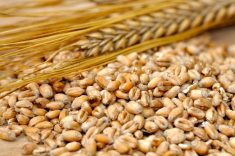Compared to last week, western Canadian yearling markets traded steady to $2 higher. Yearling prices have strengthened by $8-$10 over the past four weeks. Calf values were relatively unchanged but the market was hard to define due to limited volumes. Alberta packers were buying on a dressed basis from $300 to $302 delivered, up $1-$2 from seven days earlier. Feedlot operators that were on the sidelines earlier in August were more aggressive this week. There appeared to be an increase in buying interest. Larger yearling volumes from Saskatchewan were on offer for September and October delivery. These cattle sold for a $2-$3 premium compared to yearlings moving through the auction ring for immediate delivery. The April live cattle futures have maintained an $8 carry over the December contract justifying the price structure for deferred delivery of feeder cattle.
Read Also

U.S. livestock: Feeder cattle hit contract highs on tight supply
Chicago | Reuters – All Chicago Mercantile Exchange feeder cattle futures and most live cattle futures hit contract highs on…
At an auction market south of Edmonton, larger-frame Simmental-blended steers fresh off grass with full health data and averaging 915 lbs. sold for $234. On the video sale, larger-frame tan steers located north of Saskatoon on grass for October delivery averaging 910 lbs. dropped the gavel at $238, and Hereford-based steers averaging 980 lbs. dropped the gavel at $217, also for October delivery.
In the Lethbridge area, larger-frame Charolais-blend steers with full health records fresh off grass weighing a shade over 800 lbs. were valued at $259 landed in the feedyard. Larger-frame Angus-based heifers off pasture weighing 820 lbs. were purchased for $226 delivered in the Lethbridge area.
In central Alberta, larger-frame Angus steers fresh off grass averaging 720 lbs. reached up to $262. In central Saskatchewan mixed steers coming from pasture weighing 710 lbs. were valued at $258. Truck freight spreads were noted between Alberta and Saskatchewan.
Calves are starting to garner interest but prices remain quite variable. In central Saskatchewan, a small group of Charolais-based steers averaging a shade over 500 lbs. were purchased for $285; in central Alberta a handful of black steers weighing 525 lbs. were quoted at $266. Calves under 650 lbs. appeared to trade a premium relative to Alberta prices.
Statistics Canada released its July 1 inventory report on Aug. 23 and does a very good job of breaking down the numbers by farm type. The number of calves under one year old on cow-calf operations in Western Canada as of July 1 was 2.291 million head, down 143,800 head from the year-ago total of 2.435 million head. StatCan’s model-based survey, released Monday, had the barley crop at 9.3 million tonnes, up from the 2021 production of 6.9 million tonnes. A year-over-year decrease in calf numbers along with a year-over-year increase in barley production is a recipe for higher feeder cattle prices.
— Jerry Klassen is president and founder of Resilient Capital, specializing in proprietary commodity futures trading and market analysis. Jerry consults with feedlots on risk management and writes a weekly cattle market commentary. He can be reached at 204-504-8339 or via his website at ResilCapital.com.















